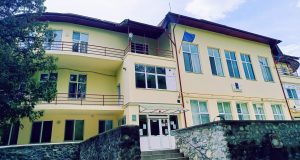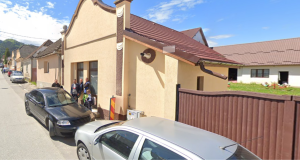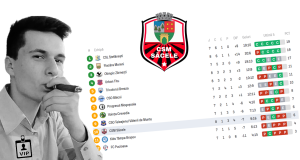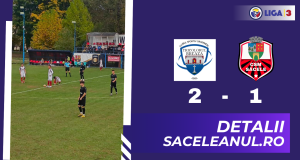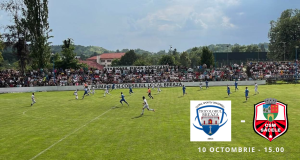De obicei când se vorbește despre ceangăi, oameni se gândesc la ceangăii din Moldova. Există trei grupări etnice regionale diferite, care poartă aceeași denumire. În această postare o să încerc să vă prezint un alt grup etnic regional, ceangăii bârseni sau ceangăii din Șapte Sate. Un grup etnic vorbitor de limba maghiară, cu un dialect asemănător de cel al secuilor, dar totuși diferit, scrie https://www.facebook.com/cristianmarchisfloresti
Satele tradiționale ceangăiești, zece la număr, dintre care patru: Baciu (Villa Abbatis, Batschendorf, Bácsfalu), Turcheș (Villa Turcica, Türkeschdorf, Türkös), Cernatu (Szent Mihály falva, Villa Sancti Michaelis, Zernendorf, Cernátfalu), Satulung (Villa Longa, Langendorf, Hosszúfalu) s-au unit și formează localitatea Săcele (Szecseleváros, Vierdörfer, Négyfalu), alte trei Tărlungeni (Tatrangia, Tatrangen, Tatrang), Zizin (Zaizonium, Zajzendorf, Zajzon), Purcăreni (Pulchretia sau Purpura, Pürkeresse, Pürkerec) alcătuiesc comuna Tărlungeni (Tatrang), împreună formând zona etnografică Șapte Sate, iar celelalte trei Apața (Villa Monachalis, Geist, Gist, Apáca), Crizbav (Villa Cancri, Krebsbach, Krizba), Satu Nou (Villa Nova, Neudorf, Barcaújfalu) se află la nord de Brașov.
 Satele lor au apărut cel mai probabil în secolul XIII lângă Brașov. Unii cercetători susțin că de fapt sunt urmașii pecenegilor (besenyők). Pecenegii au fost un popor seminomad turcofon originar din stepele Asiei Centrale. În veacul al IX-lea ei au populat nordul Mării Negre, iar în secolele al XI-lea-al XII-lea au pătruns în Peninsula Balcanică. Fiind un popor războinic, ungurii au făcut diferite pacturi cu ei, luptând de multe ori împreună. Integrarea pecenegilor în armatele feudale a condus treptat la abandonarea modului de viață nomad. Singura regiune din Transilvania unde există o concentrare masivă de toponime de origine pecenegă se află în sud-est, în județele Brașov și Covasna. Cel mai important dintre aceste toponime este chiar Brașov. Deși sufixul este slav, ceea ce a condus la presupunerea că denumirea ar fi slavă, s-a putut demonstra că Brassó, devenit apoi Brașov, provine din termenul turcic Barasu, care înseamnă „apă albă”. Și asta ar fi încă un indiciu la originea ceangăilor.
Satele lor au apărut cel mai probabil în secolul XIII lângă Brașov. Unii cercetători susțin că de fapt sunt urmașii pecenegilor (besenyők). Pecenegii au fost un popor seminomad turcofon originar din stepele Asiei Centrale. În veacul al IX-lea ei au populat nordul Mării Negre, iar în secolele al XI-lea-al XII-lea au pătruns în Peninsula Balcanică. Fiind un popor războinic, ungurii au făcut diferite pacturi cu ei, luptând de multe ori împreună. Integrarea pecenegilor în armatele feudale a condus treptat la abandonarea modului de viață nomad. Singura regiune din Transilvania unde există o concentrare masivă de toponime de origine pecenegă se află în sud-est, în județele Brașov și Covasna. Cel mai important dintre aceste toponime este chiar Brașov. Deși sufixul este slav, ceea ce a condus la presupunerea că denumirea ar fi slavă, s-a putut demonstra că Brassó, devenit apoi Brașov, provine din termenul turcic Barasu, care înseamnă „apă albă”. Și asta ar fi încă un indiciu la originea ceangăilor.
Practic există documente care atestă că ei au slujit în cetățile din zonă, ca apoi să întemeieze cele șapte sate de lângă Brașov. Așezarea acestor sate comparativ cu altele din Ardeal din aceeași perioadă denotă faptul că erau sate de grăniceri, întemeiate pentru apărarea Brașovului. Cu slăbirea necesității acestei activități de grăniceri au început să se ocupe de prelucrarea lemnului din pădurile din zonă, și fiindcă aveau relativ puține terenuri agricole au început să lucreze pământurile satelor săsești vecine în schimbul a jumătate din recoltă.
Începând din secolul XIII în diferite documente sunt numiți secui. De fapt cel mai probabil dat fiind numărul mic de pecenegi rămași, acestei comunități s-au alăturat și secui din zonă, ajungând astfel la apariția acestei comunități cu un dialect aparte.
 Pe lângă exploatare forestieră și agricultură, ocupația principală a ceangăilor a devenit transportul cu căruța, derulând comerțul în jurul Brașov, dar ajungeau și până la Istanbul, Viena sau Constanța. Caravanele lor erau bine organizate. Căruțele cu o lungime de 4 m, trase de șase cai puternici aveau o încărcătură de cca. două tone.
Pe lângă exploatare forestieră și agricultură, ocupația principală a ceangăilor a devenit transportul cu căruța, derulând comerțul în jurul Brașov, dar ajungeau și până la Istanbul, Viena sau Constanța. Caravanele lor erau bine organizate. Căruțele cu o lungime de 4 m, trase de șase cai puternici aveau o încărcătură de cca. două tone.
Una din cele mai mari “diaspore” ale ceangăilor bârseni era în București. Mult timp ceangăii bârseni se ocupau de transportul pâinii în București. Până în 1930 cel mai mulți birjari din capitală erau ceangăi, mai târziu “s-au modernizat”, devenind taximetriști.
Confesional pe vremuri erau catolici, însă prin reformarea bisericii de către Martin Luther, sub influența sașilor din zonă mulți au trecut la confesiunea evangelică luterană.
![]() Amikor az emberek a csángókról beszélnek, általában a moldvai csángókra gondolnak. De ahogy az előző bejegyzésben említettem, három különböző regionális etnikai csoport van, amelyeknek ugyanaz a nevük. Ebben a bejegyzésben egy másik népcsoportot próbálok bemutatni, a barcasági vagy hétfalusi csángókat. Magyar nyelvű népcsoport, a székelyekéhez hasonló, de mégis eltérő dialektussal.
Amikor az emberek a csángókról beszélnek, általában a moldvai csángókra gondolnak. De ahogy az előző bejegyzésben említettem, három különböző regionális etnikai csoport van, amelyeknek ugyanaz a nevük. Ebben a bejegyzésben egy másik népcsoportot próbálok bemutatni, a barcasági vagy hétfalusi csángókat. Magyar nyelvű népcsoport, a székelyekéhez hasonló, de mégis eltérő dialektussal.
Hagyományos barcasági csángó falvak, szám szerint tíz, ebből négy: Bácsfalu (Baciu, Villa Abbatis, Batschendorf), Türkös (Turcheș, Villa Turcica, Türkeschdorf), Csernátfalú (Cernatu, Szent Mihályfalva, Villa Sancti Michaelis, Zernendorf), és Hosszúfalu (Satulung, Villa Longa, Langendorf) egyesült Négyfalu (Săcele, Szecseleváros, Vierdörfer) név alatt, három másik, Tatrang (Tărlungeni, Tatrangia, Tatrangen), Zajzon (Zizin, Zaizonium, Zajzendorf), Pürkerec (Purcăreni, Pulchretia vagy Purpura, Pürkeresse) alkotja Tatrang (Tărlungeni) községet, együtt alkotva a Hétfalu néprajzi területet. A másik három Apáca (Apața, Villa Monachalis, Geist, Gist), Krizba (Crizbav, Villa Cancri, Krebsbach, Krizba) és Barcaújfalú (Satu Nou, Villa Nova, Neudorf, Barcaújfalu) Brassótól északra található.
Falvaik valószínűleg a 13. században jelentek meg Brassó közelében. Egyes tudósok szerint a besenyők leszármazottai. A besenyők Közép-Ázsia sztyeppéiről származó félnomád török nyelvű nép volt. A 9. században benépesítették a Fekete-tenger északi részét, a 11-12. században pedig behatoltak a Balkán-félszigetre. Mivel harcos nép voltak, a magyarok különböző paktumokat kötöttek velük, gyakran együtt harcoltak. A feudális seregekbe való beilleszkedésük fokozatosan a nomád életmód feladásához vezetett. Erdély egyetlen olyan régiója, ahol besenyő eredetű toponímák tömegesen fordulnak elő Brassó és Kovászna megyében található. E toponímák közül a legfontosabb maga Brassó. Brassó a török Barasu kifejezésből származik, ami „fehér vizet” jelent.
Tény, hogy dokumentumok tanúsítják, hogy a környék erődítményeiben szolgáltak, majd megalapították a Brassó melletti hét falut. Ezeknek a falvaknak az elhelyezkedése a többi hasonló, Erdélyben található, ugyanebből az időszakból származó falvakkal összehasonlítva azt mutatja, hogy ezek határőrfalvak voltak, amelyeket Brassó védelmére alapítottak. E tevékenység szükségességének gyengülésével a határőrök a környékbeli erdőkből származó fát kezdték el megmunkálni, és mivel viszonylag kevés mezőgazdasági földdel rendelkeztek, a termés feléért cserébe a szomszédos szász falvak földjeit kezdték el megmunkálni.
A 13. századtól kezdve különböző dokumentumokban székely néven említik őket. Valójában, valószínűleg a megmaradt besenyők kis száma miatt, ehhez a közösséghez csatlakoztak a környékbeli székelyek is, így alakult ki ez a sajátos dialektussal rendelkező közösség.
A fakitermelés és a földművelés mellett a csángók fő foglalkozása az áruszállítás lett, Brassó környékén kereskedtek, de egészen Isztambulig, Bécsig és Konstancáig is eljutottak. Karavánjaik jól szervezettek voltak. A hat erős ló által húzott négy méter hosszú szekerek terhelhetősége körülbelül két tonna volt.
A csángók egyik legnagyobb „diaszpórája” Bukarestben volt. A barcasági csángók sokáig kenyérszállítással foglalkoztak Bukarestben. Az 1930-as évekig a fővárosban a legtöbb fiákeres barcasági csángó volt, később „modernizálódtak”, és taxisofőrök lettek.
Kezdetben katolikusok voltak, de a Luther Márton által végrehajtott egyházi reformációval, a helyi szászok hatására sokan áttértek a evangélikus lutheránus felekezetre.
![]() Usually when people talk about the Csangos, they think of Moldavian Csangos. But as I said in the previous post, there are three different regional ethnic groups with the same name. In this post I’ll try to introduce you to another regional ethnic group, the barsensis Csangos or Seven Villages Csangos. A Hungarian-speaking ethnic group, with a dialect similar to that of the Seklers, but yet different.
Usually when people talk about the Csangos, they think of Moldavian Csangos. But as I said in the previous post, there are three different regional ethnic groups with the same name. In this post I’ll try to introduce you to another regional ethnic group, the barsensis Csangos or Seven Villages Csangos. A Hungarian-speaking ethnic group, with a dialect similar to that of the Seklers, but yet different.
The traditional Csango villages, ten in number, four of them: Baciu (Villa Abbatis, Batschendorf, Bácsfalu), Turcheș (Villa Turcica, Türkeschdorf, Türkös), Cernatu (Szent Mihály falva, Villa Sancti Michaelis, Zernendorf, Cernátfalu), Satulung (Villa Longa, Langendorf, Hosszúfalu) merged to form Săcele (Szecseleváros, Vierdörfer, Négyfalu), three other Tărlungeni (Tatrangia, Tatrangen, Tatrang), Zizin (Zaizonium, Zajzendorf, Zajzon), Purcăreni (Pulchretia or Purpura, Pürkeresse, Pürkerec) make up the commune of Tărlungeni (Tatrang), together forming the ethnographic area Seven Villages, while the other three Apața (Villa Monachalis, Geist, Gist, Apáca), Crizbav (Villa Cancri, Krebsbach, Krizba), Satu Nou (Villa Nova, Neudorf, Barcaújfalu) are located north of Brasov.
Their villages most probably appeared in the 13th century near Brasov. Some researchers claim that they are actually descendants of the Pechenegs (besenyők). The Peceneg were a semi-nomadic Turkic-speaking people originating from the steppes of Central Asia. In the 9th century they populated the northern Black Sea, and in the 11th-12th centuries they penetrated the Balkan Peninsula. Being a warior people, the Hungarians made various pacts with them, often fighting together. Their integration into the feudal armies gradually led to the abandonment of the nomadic way of life. The only region in Transylvania where there is a massive concentration of toponyms of Pecheneg origin is in the south-east, in the counties of Brasov and Covasna. The most important of these toponyms is Brasov itself. Although the suffix is Slavic, which led to the assumption that the name was Slavic, it has been shown that Brassó, later Brașov, comes from the Turkish term Barasu, meaning “white water”. And this would be another clue to the origin of the Csangos.
In fact, there are documents attesting that they served in the fortresses in the area, and then founded the seven villages near Brasov. The location of these villages compared to others in Ardeal from the same period shows that they were villages of border guards, founded for the defense of Brasov. With the weakening of the need for this activity they began to deal with the processing of wood from the forests in the area, and because they had relatively little agricultural land they began to work the land of neighboring Saxon villages in exchange for half of the harvest.
From the 13th century onwards, they are referred to in various documents as ‘Seklers’. In fact, it is most likely that due to the small number of remaining Pechenegs, this community was joined by the local Seklers, thus giving rise to this community with its own dialect.
In addition to logging and farming, the main occupation of the Csangos becam transportation, trading around Brasov, but also as far as Istanbul, Vienna and Constanta. Their caravans were well organized. The 4 m long carts, pulled by six strong horses had a load of about two tons.
One of the biggest “diasporas” of the barsensis Csangos was in Bucharest. For a long time, the Csangos were in charge of transporting bread in Bucharest. Until 1930 most of the coachmans in the capital were Csangos, later they “modernized” and became taxi drivers.
Confessionally they used to be Catholics, but with the reformation of the church by Martin Luther, under the influence of the local Saxons, many switched to the Evangelical Lutheran Church.
sursa fotot si text https://www.facebook.com/cristianmarchisfloresti
Dacă îți place să fii bine informat, te așteptăm în cea mai mare și activă comunitate online din Săcele pe pagina Saceleanul.ro și pe grupul Orașul Săcele.




